8+ SAMPLE IT Service Agreement
-
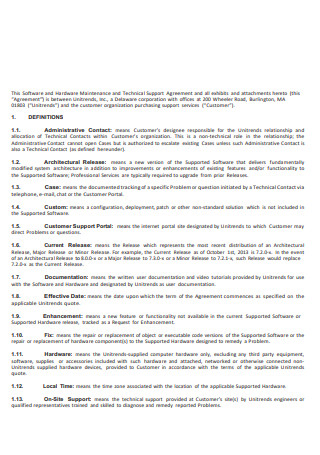
IT Technical Service Agreement
download now -
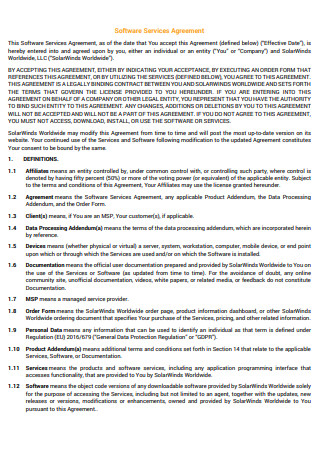
Software Service Agreement
download now -
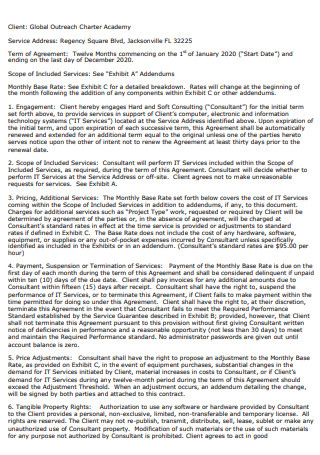
IT Service Managed Agreement
download now -
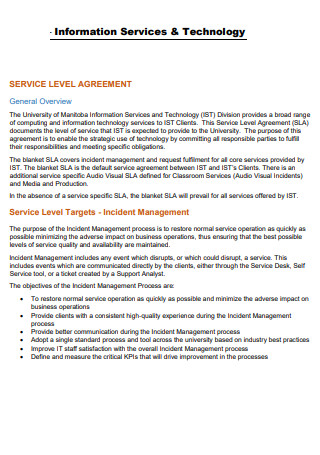
IT Service Level Agreement
download now -
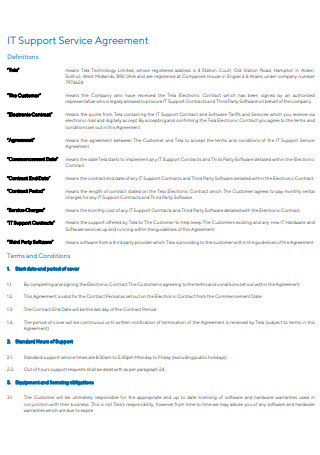
IT Support Service Agreement
download now -
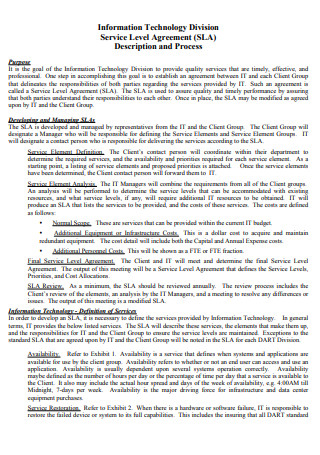
Information Technology Division Service Level Agreement
download now -
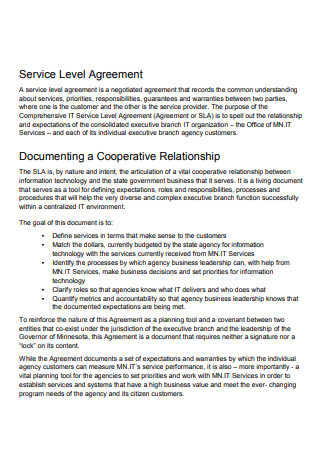
Comprehensive Information Technology Service Level Agreement
download now -
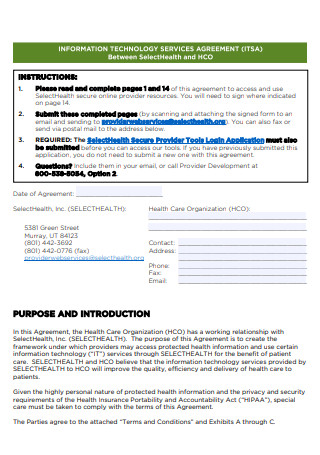
Information Technology Service Agreement
download now -
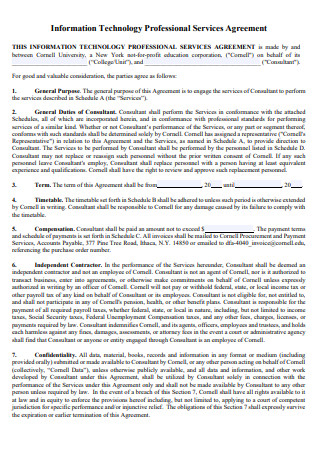
Information Technology Professional Services Agreement
download now
What Is an IT Service Agreement?
An IT service agreement is a legal and binding document between a client and an IT provider. It details the different services and levels of services that the provider offers to a client. The agreement provides a list of services, the average response time of the service provider, and the liability protection of the provider. Similar to other services agreements, the arrangement covers two parties, namely the client and provider. Other words for service agreements include service contracts or general services agreements. Most services agreement lists the rights and requirements of both parties in the agreement, including confidentiality, policies, and liability guidelines. These documents also include sections that focus on dispute resolutions when there is a breach of the contract. Service agreements are also there to minimize the occurrence of disputes arising between the parties and prevent any lawsuits that can happen due to these misunderstandings and ommissions. Service agreements can also be applicable for more than one specific job or an ongoing project that does not have an end date at the signing of the agreement.
According to the statistical information from Statista regarding the top global IT service providers by revenue for 2020, Dell Technologies tops the list by generating approximately 90 billion US dollars in global IT services revenue. Other firms that come close to Dell Technologies include IBM, with revenue of approximately 77 billion US dollars, and Cisco Systems Inc. at 51.6 billion US dollars.
Components of an IT Service Agreement
As there are various types of service agreements available in different businesses, there are components that are common in all of them. The IT service agreement must contain the following elements to make a comprehensive and fully-functional document. The section below details the components of an IT service agreement with accompanying definitions to help readers understand each component better.
How To Write an IT Service Agreement
There is no one format for writing the IT service agreement. Since there are different services that an IT agency can offer to a client, there are certain adjustments that must transpire. Since most service agreements share similar terms and conditions, it is necessary to make sure that everything is not too uniform and make sure that the service agreement addresses the necessary nature and requirements of a client. The section below helps you to create a comprehensive IT service agreement for your company or agency.
-
1. State the Length and Location of the Needed Services
The IT service agreement must specify the length of the services that they must provide. There must be a clear timeframe that the involved parties agreed upon from countless communication and partnership meetings. The IT service agreement can be for a single term, a fixed term, or one that runs indefinitely. The service agreement must also indicate the state where the work takes place and make sure that the document adheres to the state regulations and laws. It must also follow the Fair Labor Standards Act and the Service Contract Act of 1965.
-
2. Indicate a Clear Description of Provided Services
There must be an accurate description of all the IT services that you provide for the client. A detailed description reduces the risk of misunderstandings and disputes during the term of the agreement. It also gives the client a clear idea of what to expect at the end of the contract. For example, the IT service provider covers installing internet services for an organization. It must state that they are responsible for purchasing or providing a modem, running the cables around the vicinity, and handling the quality assurance of making sure the unit works properly.
-
3. Provide the Contact Information of the Parties
The IT service agreement must indicate the contact information of the involved parties. It must also state whether the client is an organization or an individual, including their names and addresses. List four contractors, at most, for the project. Having this information in the IT service agreement acts as a means of reference to contact and inform the other party regarding project details.
-
4. Outline the Compensation Provisions
There are different factors to consider when it comes to compensation, including pay rate, sales tax, payment schedules, late payments, and non-performance fees. Billing details specify the amount of money the client pays the service provider. It is also advisable to specify whether the pay rate covers sales tax or not. If the parties agree on different payment methods, describe the type of compensation. If there is an involvement of deposit payments, make sure that it is between 10 to 50 percent of the total due amount, as it acts as collateral payment or security payment for the project. Payment schedules specify the dates for payments to the service provider. Payment options depend on the type of service agreement. There must also be a specific timeframe for the client to make their payments. Specifically, it must be between 15 to 30 days. If the contractor does not pay the provider within the agreed time, they incur late fees that can go up to 25 percent of the pay rate.
-
5. Include the Terms of the Agreement
The IT services agreement must cover the terms and conditions of the relationship between the parties. Reimbursement terms enable the service provider to reimburse work-related expenses to the client with a specified guideline for additional costs. Intellectual property covers who owns the produced intellectual property during the duration of the project. A confidentiality clause is also advisable, especially when both parties share trade secrets.
-
6. Indicate Other Supplementary Clauses and Signing Details
The IT service agreement can also incorporate other clauses to address various factors, including indemnity, legal expenses, liability, and return of property. The agreement must also indicate the dates that the parties sign the document, and state whether there are any witnesses present during the signing.
FAQs
What is a service agreement?
A service agreement is a legal document between two entities, namely a contractor and a service provider. The document outlines necessary elements that describe the relationship between the parties, including pricing details, ownership, shipment details, etc.
What are the three types of contracts available?
In different industries, there are three most common types of contracts. These include fixed-price contracts, cost-plus contracts, and time and materials contracts.
Why do you need a service agreement?
Different companies require a service agreement when interacting with various entities to explain the relationship between two parties and sets clear expectations to address any issues or problems that can arise.
Writing an IT service agreement is necessary, especially when there is no proof or end product when providing services to a hiring organization or individual. A service provider must construct a well-detailed and comprehensive service agreement for the client to avoid any misunderstandings and disputes before they arise. An IT service agreement must indicate all the agreed services from the service provider to manage expectations from both parties. Develop an IT service agreement for your company by downloading from 8+ SAMPLE IT Service Agreement in PDF, only from Sample.net.
